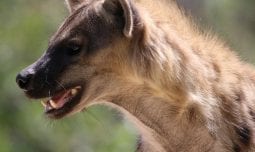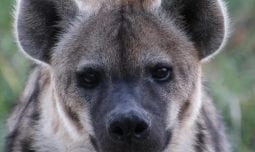Classification
Class Mammalia
Order Carnivora
Family Hyaenidae
Genus Crocuta
Species crocuta
Habitat & Range
This species is found in a wide variety of habitats: savanna, open woodland, dense dry woodland, montane and semi-desert. It is not found in extreme desert conditions, the highest mountain altitudes or tropical rainforests.
Spotted hyenas range widely throughout Africa south of the Sahara up to 13,500 ft. (4,100 m). Populations are concentrated in eastern and southern Africa, primarily in protected areas.

Spotted Hyena
Crocuta crocuta
Spotted hyenas live in female dominated groups called clans. The females in the group are related to each other but the males are unrelated. Females stay with their natal clan for life. Males disperse when they reach adulthood and join nomadic groups before settling in with a new clan. There is a separate dominance hierarchy for each sex. The highest ranking female and her descendents are dominant over all other members of the group.
Adaptations
- Large social groups help to provide protection, food and survival of young.
- Their brain’s large frontal cortex is associated with superior problem-solving skills.
- Strong jaws, teeth and digestion allow them to eat entire carcasses including skin, hooves, ligaments, horns, hair and bones.
- Spotted hyenas possess a variety of communication techniques. They have a large range of vocalizations with over 11 different sounds including yells, howls, cackles and a “whoop” that sounds like laughing to humans. Some vocalizations are loud enough to be heard several miles away. A complex set of body postures are also used in communication with other hyenas.
- To mark territory, their anal glands produce a pungent substance which is unique in chemical makeup to each individual. Urine and feces are also used to mark territory sometimes depositing feces in a communal “latrine” at the edge of their territory.
- Large heart and lungs allow them to run up to 37 mph for long distances in pursuit of prey.
- Females have more testosterone than the males making them more muscular and aggressive.
- Mostly nocturnal, their night vision and hearing are excellent.
Physical Description
- Hyenas bear some physical resemblance to wild dogs, but they are not canids. They are a separate family and more closely related to mongooses and meerkats.
- Spotted hyenas are the the largest of four hyena species (spotted, brown, aardwolf, and striped hyenas). Weight ranges from 75 to 190 lbs. (34-86 kg). Height at shoulders is 2.5 to 3 ft. (76-91 cm), body length ranges from 4 to 5 ft. (122-152 cm) and bushy tails are 10 to 14 in. (25-36 cm) long. Female hyenas are a bit larger than the males.
- Coat is short and coarse, ranging in color from sandy/yellow to grey/brown with black or dark brown spots.
- Front legs are longer than hind legs giving their back a sloping appearance. Paws have four non-retractable claws on broad toe pads.
- The head is large with round ears and a black muzzle. The neck is massive and a short, erect mane grows along the back of the head down the back.
- Strong jaw muscles are attached to a prominent sagittal crest (bony ridge on top of skull) giving them one of the strongest bites for an animal their size – 1100 lbs. per square inch (compare human’s 162 psi).
Diet
What Does It Eat?
In the wild: Spotted hyenas are carnivores that prey on animals of all types and sizes. Although often portrayed as scavengers, they are highly intelligent, skilled hunters that obtain 50% to 90% of their diet from direct kills. However, they are not picky eaters and will scavenge for food consuming carrion, bones, and vegetables. Spotted hyenas are able to eat up to 35 lbs. of meat at a single feeding.
At the zoo: Five days a week, each hyena is provided ground meat fortified with necessary nutrients. Individuals get specific amounts that help to maintain a natural body condition. Once a week, they get bones for a fast day, which they sometimes totally consume. Once a week, they receive large pieces of carcass often rabbits or pork products. On occasion, they receive larger pieces of carcass, around 100 pounds, as a group.
What Eats It?
Humans hunt spotted hyenas for meat, skins, and body parts for medicinal purposes. Although they are seldom intimidated or preyed upon, their primary rival, lions, will kill them over battles for prey.
Social Organization
Spotted hyenas are social animals that live in groups called clans, which can number up to 100 individuals. They typically hunt in groups for large prey, with larger clans breaking into smaller hunting packs. Individuals may hunt alone when going after smaller prey. Spotted hyenas live in a complex matriarchal society in which all females are dominant over males. There is also a strict hierarchy among females and among males in a clan. Females dominate hunts and females and their cubs eat before the males.
Life Cycle
Spotted hyenas live into their mid-teens in the wild and up on average into their early twenties in human care. Maturity is around three years with females maturing later than males. Mating is polygamous and controlled by females. Gestation is 110 days and typical liters are typically one to three cubs and only two usually survive. Cubs are well-developed at birth weighing about two pounds, with black fur, tiny teeth and eyes open. Cubs are raised in communal nurseries although each mother nurses her own cubs. Weaning takes place between 12 and 18 months and cubs begin eating small amounts of meat at 5 months. Offspring inherit their social rank below their mothers. Females will stay with their birth group and males will leave to join other clans.
Collection Connection
Denver Zoo is home to two hyena clans at Benson's Predator Ridge.
Young Clan These two young hyenas met as cubs when they came to DZ in 2014 from separate zoos. They were brought to DZ on a breeding recommendation from the Species Survival Plan (SSP).
Tavi (female) DOB: 6/11/2014. She is known as the official greeter of Predator Ridge. No one can walk by her without Tavi coming up to investigate. Kelele is not allowed to wake up from a nap and do anything before they first greet her.
Kelele (male) DOB: 6/26/2014. Kelele was rambunctious as a cub but has grown up to have a very sweet demeanor. His favorite activity is sleeping in cardboard boxes during the day, then tearing them up at night.
Although subordinate to Tavi, Kelele excelled over her in a study of hyena intelligence using a puzzle feeder.
Older Clan Ngozi and Kibo came to DZ together in 2004 when Predator Ridge was a new exhibit.
Ngozi (female) DOB: 5/2/1999. Ngozi is a prime example of a dominate female spotted hyena. She is larger than Kibo and will keep him away from food and make sure he knows his subordinate role. Ngozi’s favorite enrichment is spinning around in a large tub of warm water. When animals in other groups leave bones in the yard, she loves to find the ones that the keepers can’t. When she finds one, she will chase Kibo around with it to show off. She will also parade around with a large carcass for twenty minutes before starting to eat it. Ngozi has had seven cubs at DZ.
Kibo (male) DOB: 10/29/1998. Kibo enjoys the quieter parts of Predator Ridge. His day is not quite complete with a long nap. In the summer, he loves to lay in the shallow pools in the big yards. He also knows more taught behaviors than any of the other animals in Predator Ridge. Keepers are even encouraging him to create his own behaviors.
Conservation Status
IUCN Status: Least Concern
Species is widespread in Africa with an estimated population of about 10,000. However, the population outside protected areas continues to decline due to persecution and habitat loss. Declines in densities of its usual prey are also a threat. Also, a threat to survival is the negative public perception of hyenas due to their unusual appearance, strange vocalizations and scavenging tendencies.

Download the App!
Get the FREE Denver Zoo app today, and be a pro the next time you visit the Zoo. You’ll get access to the Zoo map, daily activities and schedules, animal facts, and more. You can even load your membership card onto the app for additional convenience. It puts everything you need for an amazing Zoo experience right into the palm of your hand!




